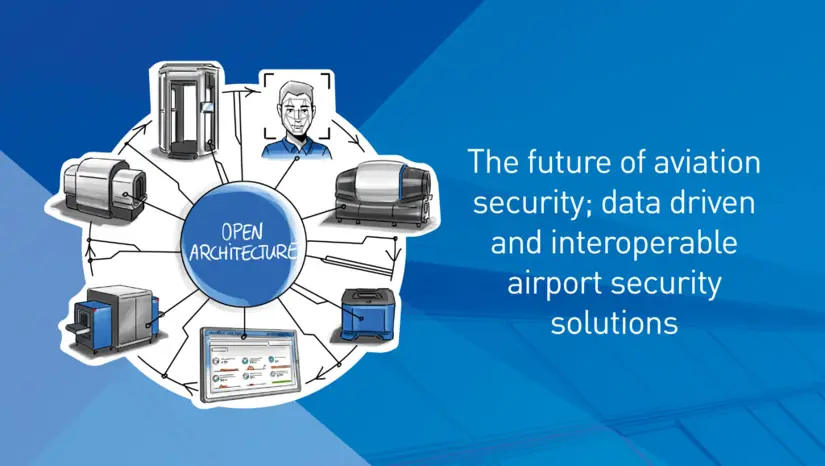The future of aviation security will be driven by data informing risk-based decisions and using integrated sensors and devices from multiple providers. It will require open equipment interfaces and common data formats with an oversight mechanism to provide assurance on aspects such as technical standards, certification and liability.
Open architecture (OA) allows hardware, software and algorithms from different suppliers to be easily ‘plugged together’. It is defined by Gartner* as: A technology infrastructure with specifications that are public as opposed to proprietary. This includes officially approved standards as well as privately designed architectures, the specifications of which are made public by their designers.
Drivers and challenges
The general perception is that, in the airport security environment, OA will deliver system flexibility; faster innovation and time to market; and less costly upgrades. The key drivers to achieve these goals are the integration of third party algorithms, data sharing and centralised image processing (CIP) – the latter is also known as multiplexed image screening.
Although common in consumer electronics, the sensitive nature of the core technology and the role of the regulator make the development of OA in airport security more complex. For safe and compliant implementation, several questions must be addressed – such as:
- Who is responsible for fault diagnosis, repair, health & safety?
- What happens if one component causes others to malfunction?
- Will configuration changes introduce new network vulnerabilities?
- Will changing one component negate regulatory compliance?
- How will overall cyber security in the airport environment be affected?
Various bodies including the Airports Council International (ACI) and the European Organisation for Security (EOS) are co-operating with regulators, suppliers and manufacturers to identify and resolve these challenges. Smiths Detection is fully committed to responsible implementation and ensuring security and compliance are never compromised. The company is an EOS member, we are collaborating closely with ACI on the framework and working with customers on Proofs of Concept (POCs).
Working to make it happen
Smiths Detection co-chairs the EOS suppliers working group and is involved in the three investigative workstreams:
- Technical
- Certification, Classified Information and Cyber security
- Commercial Liability
The workstreams were tasked with addressing several identified issues.
Integrating third party detection algorithms
The ability to have multiple algorithms from different suppliers, would significantly boost detection capabilities and meet the needs of different agencies focused on items such as drugs, currency, explosives or weapons.
To achieve this, the X-ray scanner must be able to run third party and manufacturer algorithms concurrently and quickly generate a combined result without slowing down the screening process. Alternatively, detection results from third party algorithms would have to be separately integrated into the screening operation – for example, via an additional workstation. Now under development and expected soon, DICOS 3 would support these functions by improving the transmission of large datasets.
Smiths Detection has also developed and published a Unified eValuation (UVAL) framework for 3D X-ray data. This open source tool, enables like for like comparison of 3D detection algorithms and represents a first step towards facilitating the use of third party algorithms; whilst also safeguarding algorithm quality and hence airport security.
Mixed fleet CIP
Multiplexing or central processing of images generated by fleets of screening systems from different manufacturers across several security lanes and/or airports is undoubtedly the way forward to support more effective use of resources and reduce costs.
Existing solutions are based on screen grabbing, proprietary standards or bilateral agreements – none of which are open or industry standard. Within the EOS Technical workstream, a group of vendors including Smiths Detection are working together to define a standard interface which will support CIP over mixed fleets. An agreement is expected in the summer 2022 with proposed implementation timelines to follow.
Smiths Detection is also actively pursuing proof of concept (POC) opportunities with a focus on enabling CIP for mixed fleets and integrating third party devices and images into our Checkpoint.EvoPlus solution.
Data sharing
OA will also support data sharing between airports across mixed fleets. For example, sharing baggage data and images enables screening to take place at destination and transit airports while passengers are still in the air. In some countries, this would speed up the passenger journey and provide a more positive passenger experience. Data could also be provided to other interested parties such as customs and police worldwide, informing government agencies with more precise data and helping to increase efficiency.
Networking mixed screening fleets in this way depends on standard image formats and communication protocols and complete interoperability.
What happens next?
Ultimately, we could see mixed workstations and fleets with airports swapping both hardware and software in and out of screening systems. Checkpoints are likely to be first to adopt OA, with a further impact on hold baggage, cargo and many other elements of infrastructure at a later stage. DICOS and X ray machines will probably be the first example, followed by other devices and data in future OA developments.
The underlying goal will always be to improve operational performance, security outcomes and passenger experience – OA is a new means to that end. Similarly, the aim at Smiths Detection is to help solve business problems and meet operational requirements plus shortening and maximising the return on investment period for customers. We are committed to OA and will continue to work with all stakeholders to address the challenges and risks and move it forward towards execution.
It is indeed an exciting time for the industry and many positive steps have been taken – but there are still hurdles to negotiate, so watch this space for more news and progress.
*https://www.gartner.com/en/information-technology/glossary/open-architecture

